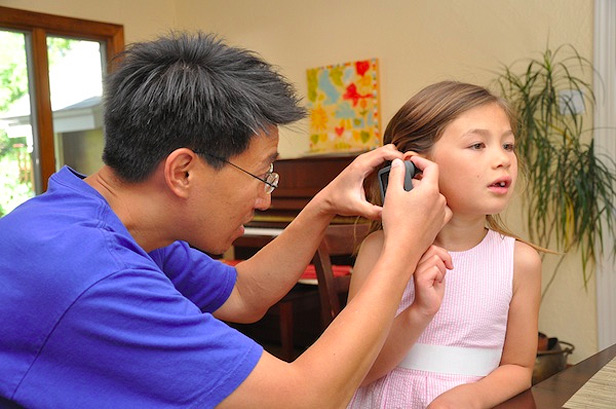Parents Could Skip the Doctor’s Office with This Device

Many parents have experienced the angst of a crying baby with an ear infection. Some 30 million medical visits in the U.S. alone are due to pediatric ear infections each year.
A startup called CellScope has developed a device that could make such visits unnecessary. It connects to an iPhone and produces a view inside the ear magnified by a factor of 10. Users can capture and upload images to CellScope’s Web platform. After adding notes about other symptoms, parents could ask their own doctor to conduct a remote exam. In most cases, that would be enough information for a prescription to be called in, says CellScope CEO Erik Douglas.
This week, CellScope raised $1 million from Khosla Ventures to work on this smart-phone-connected version of the otoscope, the common instrument doctors use to look inside ears and diagnose infections.
CellScope, which graduated from the Rock Health health-care IT incubator last year, is an example of the recent surge of health-related devices and applications for smart phones. Already, patients can track their fitness, take their blood sugar, and even detect malaria using phones and connected devices. Juniper Research predicts there will be 142 million downloads of mobile health apps by 2016.
Mike Wisz, a health-care technology consultant, says CellScope is interesting for its potential to reduce office visits and the costs of care. The images it captures might also allow parents to more easily seek a second opinion, and could be stored in a child’s electronic health records for future reference, he says.
CellScope’s technology was first developed at the University of California, Berkeley, where bioengineering professor Daniel Fletcher’s research team produced a mobile microscope that is used to diagnose tuberculosis in developing countries (see “A Cell-Phone Microscope for Disease Detection”).
Douglas, who worked on that project, says the company was formed to commercialize the concept. It’s starting with simple uses that require lower magnification.
The company is pilot-testing its mobile otoscope with doctors in the Bay Area, and conducting a clinical study to show that the images are as good as other diagnosis methods, says Douglas. The device will be marketed to consumers, although a user’s doctor would have to okay with the unconventional method. The price isn’t determined yet, but wouldn’t be out of the range of other iPhone accessories, Douglas says.
CellScope is developing other uses for mobile microscopy and imaging to build a “digital first aid” kit. One upcoming product, a dermascope, would produce diagnostic-quality images of skin ailments. After ear infections, skin rashes are the second leading reason for pediatrician visits, the company says.
Keep Reading
Most Popular
Large language models can do jaw-dropping things. But nobody knows exactly why.
And that's a problem. Figuring it out is one of the biggest scientific puzzles of our time and a crucial step towards controlling more powerful future models.
How scientists traced a mysterious covid case back to six toilets
When wastewater surveillance turns into a hunt for a single infected individual, the ethics get tricky.
The problem with plug-in hybrids? Their drivers.
Plug-in hybrids are often sold as a transition to EVs, but new data from Europe shows we’re still underestimating the emissions they produce.
Stay connected
Get the latest updates from
MIT Technology Review
Discover special offers, top stories, upcoming events, and more.